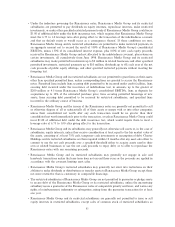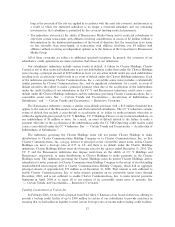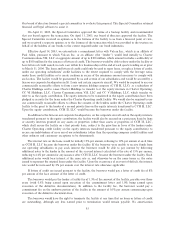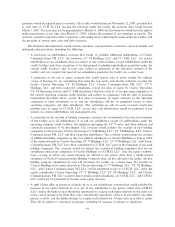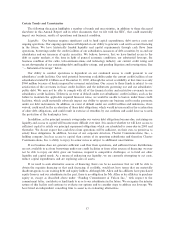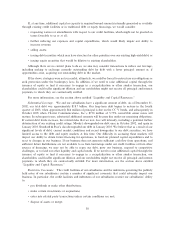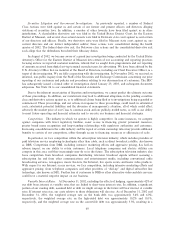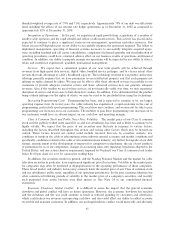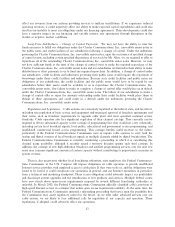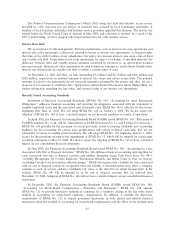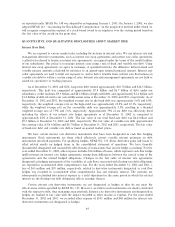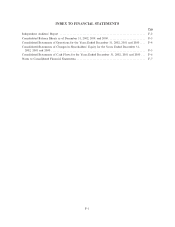Charter 2002 Annual Report Download - page 59
Download and view the complete annual report
Please find page 59 of the 2002 Charter annual report below. You can navigate through the pages in the report by either clicking on the pages listed below, or by using the keyword search tool below to find specific information within the annual report.Certain Trends and Uncertainties
The following discussion highlights a number of trends and uncertainties, in addition to those discussed
elsewhere in this Annual Report and in other documents that we Ñle with the SEC, that could materially
impact our business, results of operations and Ñnancial condition.
Liquidity. Our business requires signiÑcant cash to fund capital expenditures, debt service costs and
ongoing operations. Our ongoing operations will depend on our ability to generate cash and to secure Ñnancing
in the future. We have historically funded liquidity and capital requirements through cash Öows from
operations, borrowings under the credit facilities of our subsidiaries, issuances of debt securities by us and our
subsidiaries and our issuances of equity securities. We believe, however, that we have limited access to the
debt or equity markets at this time in light of general economic conditions, our substantial leverage, the
business condition of the cable, telecommunications and technology industry, our current credit rating and
recent downgrades of our outstanding debt and liquidity ratings, and pending litigation and investigations. See
""Ì Substantial Leverage'' below.
Our ability to conduct operations is dependent on our continued access to credit pursuant to our
subsidiaries' credit facilities. Our total potential borrowing availability under the current credit facilities of our
subsidiaries totaled $1.4 billion as of December 31, 2002, although the actual availability at that time was only
$944 million because of limits imposed by covenant restrictions. Our access to those funds is subject to our
satisfaction of the covenants in those credit facilities and the indentures governing our and our subsidiaries'
public debt. We may not be able to comply with all of the Ñnancial ratios and restrictive covenants in our
subsidiaries' credit facilities. If there is an event of default under our subsidiaries' credit facilities, such as the
failure to maintain the applicable required Ñnancial ratios, we would be unable to borrow under these credit
facilities, which could materially adversely impact our ability to operate our business and to make payments
under our debt instruments. In addition, an event of default under our credit facilities and indentures, if not
waived, could result in the acceleration of those debt obligations, which would in turn result in the acceleration
of other debt obligations, and could result in exercise of remedies by our creditors and could force us to seek
the protection of the bankruptcy laws.
In addition, as the principal amounts owing under our various debt obligations become due, sustaining our
liquidity and access to capital will become more diÇcult over time. It is unclear whether we will have access to
suÇcient capital to satisfy our principal repayment obligations which are scheduled to come due in 2005 and
thereafter. We do not expect that cash Öows from operations will be suÇcient, on their own, to permit us to
satisfy these obligations. In addition, because of our corporate structure, Charter Communications, Inc., a
holding company, has less access to capital than certain of its operating subsidiaries and therefore Charter
Communications, Inc.'s ability to repay its senior notes is subject to additional uncertainties.
If our business does not generate suÇcient cash Öow from operations, and suÇcient future distributions
are not available to us from borrowings under our credit facilities or from other sources of Ñnancing, we may
not be able to repay our debt, grow our business, respond to competitive challenges, or to fund our other
liquidity and capital needs. As a means of enhancing our liquidity, we are currently attempting to cut costs,
reduce capital expenditures and are exploring sales of assets.
If we need to seek alternative sources of Ñnancing, there can be no assurance that we will be able to
obtain the requisite Ñnancing or that such Ñnancing, if available, would not have terms that are materially
disadvantageous to our existing debt and equity holders. Although Mr. Allen and his aÇliates have purchased
equity from us and our subsidiaries in the past, there is no obligation for Mr. Allen or his aÇliates to purchase
equity or, except as described above under ""Funding Commitment of Vulcan Inc.,'' with respect to the
commitment letter, contribute or lend funds to us or to our subsidiaries in the future. We recognize the interim
nature of this facility and continue to evaluate our options and to consider steps to address our leverage. We
have hired an independent consulting Ñrm to assist us in evaluating alternatives.
57






